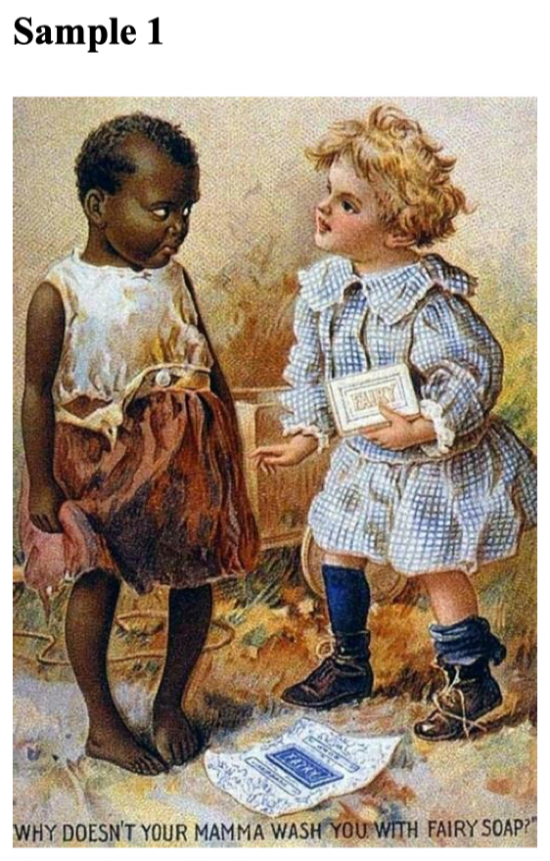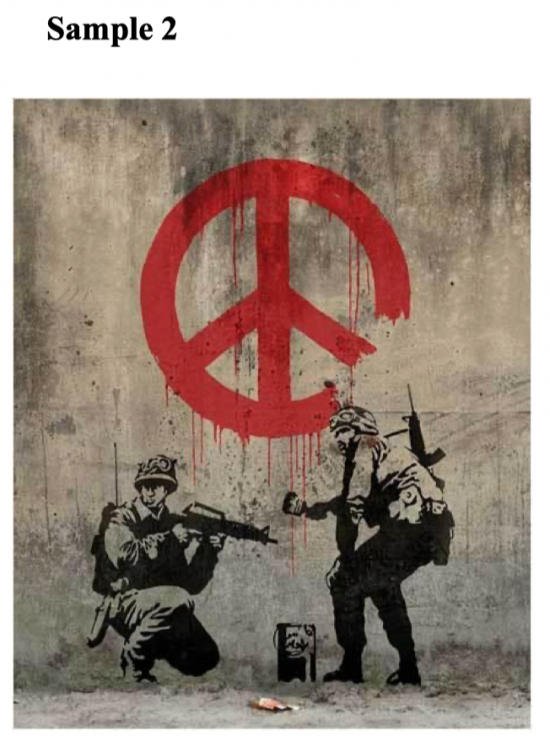Writing a Comment — 20
You are going to read an encyclopedic article on a famous artist. Using the information from the text or your background knowledge, explain why the works of art following the text could (or could not) be created by the said artist.
Banksy is an anonymous British graffiti artist known for his antiauthoritarian art, often done in public places.
Though Banksy’s identity was well guarded, he came to notice as a freehand graffiti artist in 1993. Using stencils since 2000 to enhance his speed, he developed a distinctive iconography of highly recognizable images, such as rats and policemen, that communicated his antiauthoritarian message. With wry wit and stealth, Bansky merged graffiti art with installation and performance. In the 2003 exhibition Turf War, Bansky painted on the bodies of live pigs. At his Crude Oils exhibition in London in 2005, which featured altered replicas of the works of Claude Monet, Vincent van Gogh, and Edward Hopper, he released 200 live rats in the gallery.
In 2005 Banksy painted a wall on the Palestinian side of the West Bank; on the viewer’s side, children play on a forelom patch of earth, while through an apparent hole in the wall there is a scene of a perfect tropical beach. Banksy described himself as a “quality vandal,” challenging the authority of political and art institutions on both the right and the left. In September 2006 his one-weekend Los Angeles warehouse installation Barely Legal, for which he decorated a live elephant, attracted large crowds despite a lack of publicity. In Bristol, Eng., in 2006 he depicted a naked man clinging to a windowsill on the side of a public family-planning clinic; local residents voted to keep the mural. In 2009 he staged a surprise show at the City Museum and Art Gallery in Bristol. It featured animatronics, oil paintings, and an old ice-cream truck.
Banksy’s books—which include Banging Your Head Against a Brick Wall (2001), Existencilism (2002), and Wall and Piece (2005)—document his projects; iconic examples of his work, including a life-size image of two policemen kissing, were featured in the bleak futuristic film Children of Men (2006). Banksy directed the 2010 film Exit Through the Gift Shop, a documentary that ostensibly profiled the lives and work of the world’s most talented graffiti artists. Critics were divided on the film, though, as some chose to accept it at face value while others saw it as a satire, with documentary subject and filmmaker-turned-street artist Thierry Guetta (who some theorized was an actor paid by Banksy or was, perhaps, Banksy himself) serving as a commentator on the commercialization of art.
Peter Gibson, a spokesman for Keep Britain Tidy, asserts that Banksy’s work is simple vandalism, and Diane Shakespeare, an official for the same organisation, was quoted as saying: ”We are concerned that Banksy’s street art glorifies what is essentially vandalism.”
Banksy has also been long criticised for copying the work of Blek le Rat, who created the life-sized stencil technique in early 1980s Paris and used it to express a similar combination of political commentary and humorous imagery. Blek has praised Banksy for his contribution to urban art, but said in an interview for the documentary Graffiti Wars that some of Banksy’s more derivative work makes him "angry”, saying that "It’s difficult to find a technique and style in art so when you have a style and you see someone else is taking it and reproducing it, you don’t like that."
Some have criticised the "obviousness" of Banksy’s work and accused it of being "anarchy-lite" geared towards a middle class "hipster" audience. Much of this criticism came forward during his series of works in New York in 2013. Many New York street artists, such as TrustoCorp, criticised Banksy, and much of his work was defaced.
There exists a cult-like following for the artist. The ambiguity of his identity has drawn this group of followers. A concept, the "Banksy effect" has developed as a result of Banksy’s artistic innovation. This term is in reference to the artist’s ability to turn outsider art into the cultural mainstream. It was coined to reference the way in which Banksy’s work has led to an increased interest in street art. Street art has been incorporated into being a part of culture and daily life. His work in turn, has questioned the authenticity of art and its creators, furthering the cultural debate that has existed for centuries.
In January 2011, he was nominated for the Academy Award for Best Documentary for Exit Through the Gift Shop. In 2014, he was awarded Person of the Year at the 2014 Webby Awards. In 2014, young adults from abroad named Banksy a British cultural icon in a list that included William Shakespeare, Queen Elizabeth II, David Beckham, The Beatles, Charlie Chaplin, J. K. Rowling, Elton John, and Adele.
Although he was increasingly famous, Banksy remained anonymous; his rare interviews were conducted via e-mail or with responses delivered by an altered voice on tape. He remained committed to street art, declaring that life in a city in which graffiti was legal would be “like a party where everyone was invited.”
Look at the following works of art. Could they be created by Banksy? Explain why/why not. Pay special attention to the message of the artwork. Write 100-120 words.
олимпиады 10 класс, олимпиады 11 класс, picture-based, Ломоносов финал 10–11, freestyle, olympic writing 2019/20, art, Banksy

